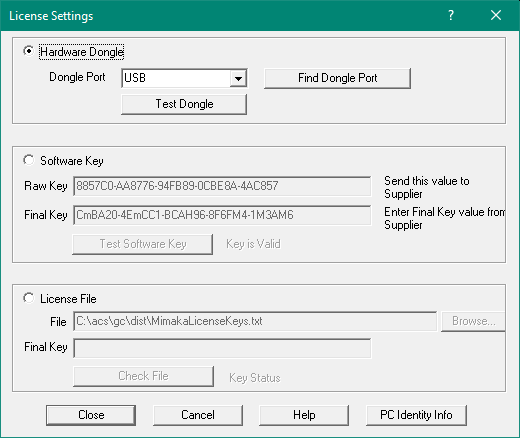Contents
Index
License Settings
The software will be 'locked' and will not have full functionality until the software license has been implemented.
The License Settings is located under the File Menu by selecting Settings then License.

There are two different ways of ‘unlocking’ the software: by using a hardware dongle connected to a serial port, or by entering a Software Key which is unique to your PC.
Hardware Dongle
If you have a hardware dongle, check the dot next to 'Hardware Dongle' to activate the Dongle Port drop down list.
Dongle Port
If you know what port your hardware dongle is attached to, choose this Communication or Com Port from the drop down list.
Find Dongle Port
If you are unsure as to which Communication or Com Port your hardware dongle is attached to, press the Find Dongle Port button to have the program locate the dongle for you.
Test Dongle
Once the correct port is specified, press the Test Dongle button to check if the hardware dongle is valid.
Software Key (See Software Key for more information)
If you don't have a hardware dongle and will be using a Software Key, check the dot next to 'Software Key' to activate the Raw Key and Final Key boxes.
Raw Key
This is a value generated by the program that is individual to your computer. It consists of 4 sets of 6 letter/number combinations seperated by a hyphen. Send this value to the supplier of the software and a Final Key will be generated for you.
Final Key
This is a value generated and supplied to you by the supplier of the software. It consists of 4 sets of 6 letter/number combinations seperated by a hyphen.
Test Software Key
Press this button to test the Software Key Settings entered. If the result is that the Key is Invalid, check the value entered for the Final Key and make sure that it is entered exactly as supplied to you by the supplier of the software. If the value is entered correctly, it will state that the Key is Valid.
Windows NT, Window 2000 Dongle Detection
Use the program option File\Settings\License to detect the hardware dongle on a particular port. This option will open the port COM1, COM2 etc and will detect and display any system error messages. See Laptops for more information about Laptop computers and their serial ports.
Select the port you think the dongle is on, and press the Test Dongle button.
Under Windows NT/ 2000 a typical error is:
Error: Access is denied
This indicates that another program has the serial port reserved and this program cannot get access to the port.
Error: The system cannot find the file specified
The COM port you specified does not exist on your PC.
Error: Diagnostic code = 0
The port is available but the software lock is not present or not responding.
Connection Cables
The hardware dongle is a 25 pin device. Most PCs now only come with two 9 pin connectors. It is best to buy a 9-25 adaptor to connect the dongle to the PC. These usually cost about $10, get one with a cable about 1m long if possible.
Spec
9 pin Female to 25 pin Male connector
DOS Programs Only
A configuration file can now be set up to tell the program which port to check for the hardware dongle. Create the file ACS.CFG in the C:\ACS directory and insert a line like 'Lock Port=COM1', or 'COM2' or 'LPT1' or 'LPT2'. Make sure there are no extra spaces. A sample file is shown here, remove ! on the line you want.
Note that the pan factor affects how far the arrow keys pan in Cad20/Topo60, a factor of 0.2 moves 20% of the window width per keystroke.
Pan Factor = 0.1
!
! remove the ! from in front of the com port with the lock
! Place this file in the c:\acs directory
!
!Lock Port =COM1
!Lock Port =COM2
